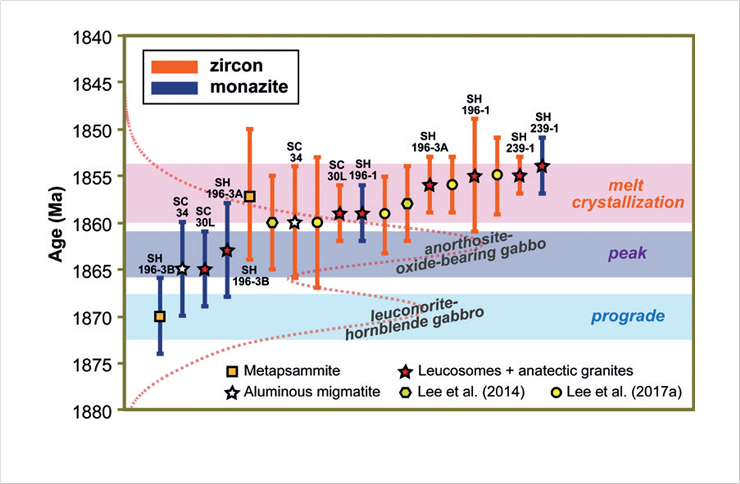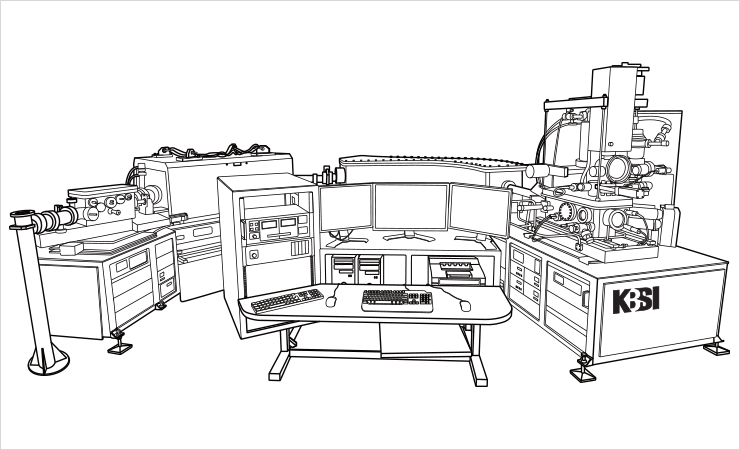Sensitive High Resolution Ion MicroProbe
Sensitive High Resolution Ion MicroProbe Leading-edge Equipment Home
Equipment Introduction
Sensitive High Resolution Ion MicroProbe(SHRIMP), which can measure the isotope ratio for microscopic areas of surface in solid materials, has been operated for researches on geotectonic age and surface analysis of trace isotope elements.
Characteristics of the Equipment
- KBSI SHRIMP is the first high resolution secondary ion mass spectometry in Korea.
- It has low detection limit (~1 ppm) with 10,000 mass resolution and 50% transmission.
- Multi-collection system with charge-mode electrometers can measure Pu isotopes simultaneously
Representative Research Case
Prolonged high-temperature, low-pressure metamorphism associated with ~1.86 Ga Sancheong- Hadong anorthosite in the Yeongnam Massif
SHRIMP U-Th-Pb ages of zircon and monazite from migmatitic gneisses in the Sancheong-Hadong area, Yeongnam Massif has shown that the high-temperature, low-pressure metamorphism associated with anorthosite lasted over a period of ~15 Ma, corresponding to the last stage of Paleoproterozoic (~1.95-1.85 Ga) hot orogenesis in the North China Craton.
 Timeline diagram showing progressive high-temperature, low-pressure metamorphism
Timeline diagram showing progressive high-temperature, low-pressure metamorphism
Application
 U-Pb geochronology
U-Pb geochronology In situ isotopic measurement of microtexture
In situ isotopic measurement of microtexture
Representative Research Papers
-
Lead oxide nanospheres in seismically deformed zircon grains
Kusiak M.A., Kovaleva E., Wirth R., Klötzli U., Dunkley D.J., Yi K., Lee S.,
Geochimica et Cosmochimica Acta, 2019, 262(), PP 20-30, doi:10.1016/j.gca.2019.07.026 -
Tectonomagmatic evolution of a Jurassic Cordilleran flare-up along the Korean Peninsula: Geochronological and geochemical constraints from granitoid rocks
Cheong A.C.-S., Jo H.J.
Gondwana Research, 2020, 88, pp 21-44, doi:10.1016/j.gr.2020.06.025 -
Late Paleoproterozoic evolution of the buried northern Gawler Craton
Armit R., Betts P.G., Schaefer B.F., Yi K., Kim Y., Dutch R.A., Reid A., Jagodzinski L., Giles D., Ailleres L.,
Precambrian Research, 2017, 291 (), pp 178-201, doi:10.1016/j.precamres.2017.01.023 -
Eocene granitoids of northern Turkey: Polybaric magmatism in an evolving arc–slab window system
Yener Eyuboglu, Francis O. Dudas, Derek Thorkelson, Di-Cheng Zhu, Ze Liu, Nilanjan Chatterjee, Keewook Yi, M. Santosh,
Gondwana Research GR-01810; No of Pages 35 (2017), doi: 10.1016/j.gr.2017.05.008 -
Metamorphic and magmatic evolution of the Paleoproterozoic gneisses in the Sancheong area, Yeongnam Massif, South Korea, and their implications to the tectonics in the Northeast Asia
Byung Choon Lee, Jong Hyun Park, Chang Whan Oh, Keewook Yi,
Precambrian Research 298, 439-461 (2017), doi: 10.1016/j.precamres.2017.06.001 -
Early oligocene partial melting via biotite dehydration melting and prolonged low-pressure–low-temperature metamorphism of the upper high himalaya crystalline sequence in the far east of nepal
Imayama T., Takeshita T., Yi K., Fukuyama M.,
Geological Society Special Publication, 2019, 481(1), PP 147-173, doi:10.1144/SP481.2 -
Crustal evolution in the Gyeongsang Arc, southeastern Korea: Geochronological, geochemical and Sr-Nd-Hf isotopic constraints from granitoid rocks
Albert Chang-Sik Cheong, Hui Je Jo,
American Journal of Science vol. 317 no. 3, 36-410 (2017), doi: 10.2475/03.2017.03 -
In-situ oxygen isotope records of crustal self-cannibalization selectively captured by zircon crystals from high-δ26Mg granitoids
Hui Je Jo, Albert Chang-sik Cheong, Jong-Sik Ryu, Namhoon Kim, Keewook Yi, Haemyeong Jung, Xian-Hua Li,
Geology (2016) 44 (5): 339-342, doi: 10.1130/G37725.1 -
Crustal thickening by tectonic wedging of the Ganderian rocks, southern New England, USA: Evidence from cataclastic zircon microstructures and U–Pb ages
Robert P. Wintsch, Keewook Yi, Michael J. Dorais,
Journal of Structural Geology 69, 428-448 (2014), doi: 10.1016/j.jsg.2014.07.019 -
Tracing Archaean terranes under Greenland's Icecap: U–Th–Pb–Hf isotopic study of zircons from melt-water rivers in the Isua area
Keewook Yi, Vickie C. Bennett, Allen P. Nutman, Seung Ryeol Lee,
Precambrian Research 255, 900-921 (2014), doi: 10.1016/j.precamres.2014.04.006




